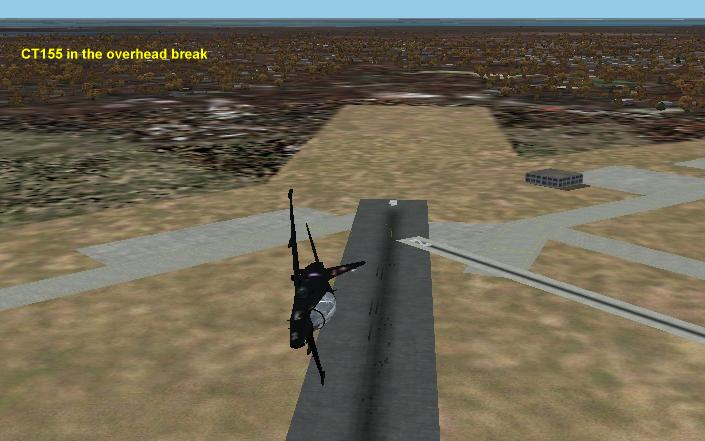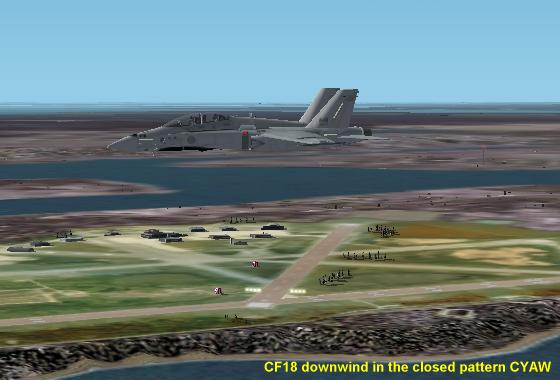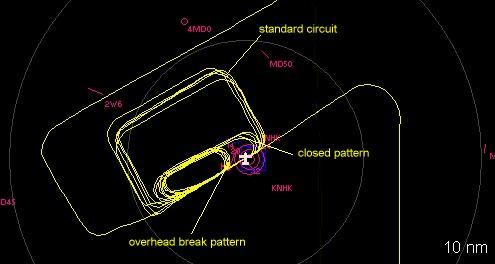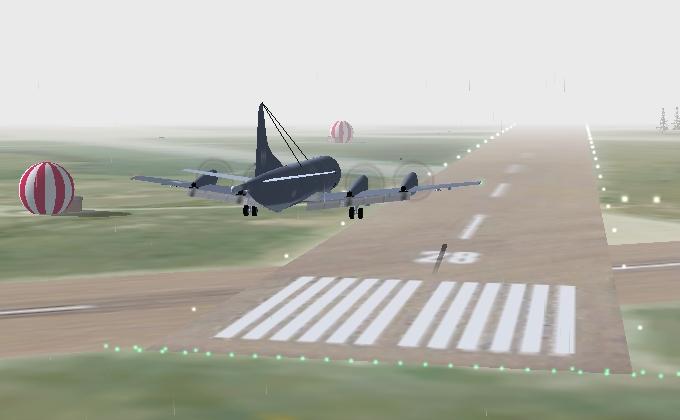Military VFR/IFR Aerodrome Procedures
The CanadianForces,
as well as other NATO military air forces, utilize different and varied
procedures in and around landing airports. In
the VATSIM world it is very important that virtual aviators and controllers
are familiar with these patterns so that operating irregularities can be
avoided. In this discussion we will look at several
different military specific procedures from the cockpit and from the Air
Traffic Control point of view. It can be quite
challenging, as well as rewarding, to work a successful pattern full of
CF18, Hawks as well as other hi performance aircraft.

Perhaps the most common hi performance jet VFR
pattern is the Flat Overhead Break.
The break is flown by aligning the aircraft to the runway heading
at 5 miles from the airport at 1000-1500 feet AGL and an indicated airspeed
of 250-300 knots. The pilot reports initial at 3 miles from the runway and this is normally where
the sequence number is given. The pilot flies
the jet over the runway threshold, maintaining altitude and speed, and over
the numbers carries out a steep circular arrival pattern planned to roll
out on final on speed configured for landing. The
pilot will report on base leg or short final and this is where the runway
clearance is normally issued. The pattern may
be flown left or right hand – usually dependant on other circuit traffic -- ie
you may run conventional circuits right hand and the break pattern
left.
KUGR42 –
call initial
righthand break 1500’
--------------------------------------------
Tower – KUGR42 initial
rwy 34
KUGR42 - #1 or
KUGR42 - #2 follow
the SeaKing on final; break midfield or
KUGR42 - #2 follow
the CF18 ahead in the break
---------------------------------------------
Tower KUGR42 – base
gear down and locked for a touch and go
KUGR42 - winds 360
at 5 rwy34 cleared touch and go
or
KUGR42 - continue C130
clearing at Charlie or
KUGR42 - pull up and
go around vehicle on the runway
A subtle variation of the overhead break I have
seen in use is the Battle Break -- this is virtually the
same pattern but the aircraft arrives initially over the runway threshold
quite low and pulls up over the upwind end in the same steep circular pattern
arriving at the downwind/base legs in virtually the same configuration
as for the overhead.

The second most common VFR pattern is the Closed Circuit. This is normally
conducted on the pullup from a touch and go
or low approach and is quite similar to a standard circuit pattern although
much tighter and faster. The closed pattern
is flown within 1 mile on the downwind and the turn to final within 3 miles
of the threshold at an altitude of 1000 feet AGL and an indicated speed of
250-300 knots. The pilot makes the same calls as a standard circuit -- ie downwind and final -- and ATC provides a
sequence number on the downwind and a runway clearance on the base/final
leg.
Tower – SKNR22 request
closed left
SKNR22 – cleared left
---------------------------------------------
Tower – SKNR22 downwind
touch and go
SKNR22 - #1 or
SKNR22 - #2 follow
the
SKNR22 - #3 following
an A310 on a 5 mile final extend the downwind
---------------------------------------------
Tower – SKNR22 base,
gear down and locked for a touch and go
SKNR22 – winds 360
at 5 rwy34 cleared touch and go
or
SKNR22 – pull up and
go around aircraft on the runway
The following graphic gives you an idea of the
relative positions in the patterns we have discussed so far. These were flown on rwy06 at

The next pattern we will review is the Practice Forced Landing
-- PFL.
The pilot will normally request the pattern when approaching or leaving
the circuit to rejoin. Once approval has been
granted from the tower controller – the pilot will align the aircraft to
a position over the runway threshold on runway heading at 250kias and 5000’AGL. This position is called HiKey. The pilot then secures
the engine for an idle thrust 360 degree circular descent to the runway, again with the intention of rolling final 1-2
miles back on speed and in configuration. The
3 radio calls in this pattern are
HiKey (already
discussed), LoKey
(halfway through the PFL in a relative downwind position – ATC normally
assigns a sequence number here), and FinalKey
(rolling in final – ATC normally gives the runway clearance here). Remember the aircraft is simulating an emergency
descent – it is quite difficult to have him extend the pattern as he’s bleeding
off altitude and speed to arrive in the landing configuration on short final.
RUTT16
righthand PFL
approved call HiKey
-----------------------------------------------
Tower RUTT16 HiKey rwy31R
RUTT16 roger – call
LoKey
-----------------------------------------------
Tower RUTT16 LoKey
RUTT16 roger #1 or
RUTT16 roger #2 follow
the T33 short final
-----------------------------------------------
Tower RUTT16 FinalKey – 3 down and locked for a go
RUTT16 winds 290 at
10 rwy 31R cleared touch and go
These are basically the most common hi performance
maneuvers you will encounter – when I state hi performance let me also
remark that I have seen overheads flown by CP140s/C130s etc and closed
patterns by twin huey helicopters. All military pilots and controllers should be familiar
with these procedures.
A few other military specific procedures you
may (or may not) be familiar with are:
TACAN -- a TACAN (Tactical
Air Navigation) is quite similar to the civilian VOR.
When you hear a pilot request a TACAN approach – treat it the same
as a VOR or VOR/DME approach.
ROUND ROBIN FLIGHT -- military pilots
often file a round robin flight plan for enroute
training and approaches at several different airports.
Treat this flight similarly to a civilian training flight -- issue the final airport as the clearance limit via
the routing to the first airport for approaches and flightplanned route. For
example: Swordfish22, a CP140 from 415 squadron
CYZX
à YHZ
(ILS APPCH +15) à YQM
(NDB APPCH +15) à YSJ
(GPS APPCH +15) à CYZX
Your clearance would be…
ATC clears SFSH22 to
the Greenwood TACAN via direct YHZ flightplanned
route, maintain 9000
Depart rwy 26 turn left climb on course squawk 4205
OPERATIONAL/DUE REGARD -- this is a term
used by the military that indicates the flight is proceeding on a National
Defense mission and no longer requires an ATC clearance.
Normally you need only acknowledge the report and pass on any relevant
traffic.
HNTR82 Moncton roger – radar service terminates, cleared
enroute
ARRESTOR CABLES -- at many military
airports the runways are equipped with arrestor cables similar to what
you might find on an aircraft carrier. These
are normally rigged when tailhook equipped aircraft
are operating at the aerodrome. A cautionary
is issued with takeoff/landing clearances.
SGNYBLUES winds 280
at 5 departure end cable rwy 26 in the up position
cleared takeoff
PAR/GCA -- for many years the main landing approach navigation
aid at DND aerodromes was PAR (Precision Approach Radar)
This system uses a very precise radar to allow a specially trained
controller to ‘talk down’ the pilot right to 200 and ½ minimums
on a Ground Controlled Approach.
